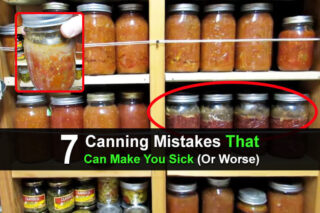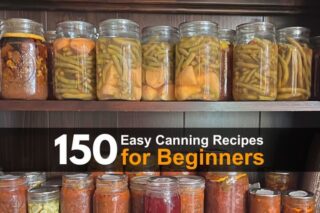Estimated reading time: 6 minutes
Preserving food grown in the garden is a time-honored tradition passed down from generation to generation. Canning has been around for centuries, but it is now seeing a significant comeback as consumers understand the value of fresh produce grown at home. People who know how to can food not only stockpile food for the winter but also make use of food that otherwise would have gone to waste.
Canning may seem a bit overwhelming, but it really doesn’t have to be. While certain foods are harder to can, there are also many foods that are very easy to can — perfect for those homesteaders who are beginning to learn the canning process.
Canning does take some time to learn, but the rewards are huge when you open a jar of fresh green beans in the middle of winter. If you are new to canning food, start with these five foods which are fairly easy to can:
Want to save this post for later? Click Here to Pin It on Pinterest!
1. Strawberry Jam
There is nothing like harvesting your very own strawberries at the beginning of the summer season. At the height of the berry season, you’ll find yourself making strawberry salads, fruit salads, and smoothies. However, one of the best ways to preserve the sweet taste of summer is to make your own strawberry jam.
There are many strawberry jam recipes out there that include pectin, but there are also simple recipes that are just as good. Choose a recipe that you like and pour the mixture into the desired sterile canning jar.
Always leave a little bit of room at the top for sealing and use a water bath to seal the jam for 10 minutes. Pay attention to different processing times depending on the sizes of cans that you use as well.
2. Green Beans
If you are new to homesteading, you may have heard stories of past generations who spent hot summer afternoons snapping beans. Canning green beans is an easy process and a great way to store fresh vegetables for use during the winter. You’ll need to can green beans in a pressure canner because beans have such low acidity.
Cut off the ends of the beans and snap them into bite-size pieces. Tightly pack them into a clean and sanitized canning jar. Add some water to fill up the jar and leave some space for air at the top. Add in some salt if you prefer as well. Process the green beans by placing at least 2-quart jars in the pressure canner for 25 minutes at ten pounds of pressure.
3. Tomatoes
Nothing is better than a fresh tomato off the vine during the peak of summer. Tomatoes can be canned using a pressure canner or a water bath canner if you add enough acidity to your jars. Tomatoes are low in acid so pressure canning them is the best method to be safe.
Blanch the tomatoes to easily remove the skin and cut them up according to which recipe you use. Place the tomatoes in a sterile jar and boil in a water bath system for about 45 minutes.
There are also many seasoning packets that you can add to your tomatoes depending on what you like to make. Making fresh salsa is a favorite as well as tomato or pasta sauce. You can also add your own spices depending on what you would like to make. Be careful to process tomatoes long enough if you add other ingredients, though.
4. Corn
Late summer brings forth plenty of corn on many homesteads across the nation. Even if you didn’t grow any corn, you can usually find some at the neighbor’s or on sale at the local grocery store.
Canning corn is a great way to preserve the fresh taste of corn off the cob and can be quite a fun chore. You’ll need to process the corn in a pressure canner as the corn has low acidity.
There are many different ways to can corn, but you will most likely be in one of the two camps: raw or blanched. For raw corn, just cut the corn off the cob and place it directly into a sterile canning jar. If you want to blanch the corn, dip the ears in boiling water for two minutes and then place them in an ice bath.
Salt is usually added for extra flavor and preservation. Corn does take longer to process than other foods at about 85 minutes for quarts in the pressure canner. Consider trying both styles to see which taste you prefer.
5. Pickles
Cucumbers are one of those plants that tend to do very well in the garden. Just a few seeds can produce a huge amount of cucumbers that will leave you wondering how to use them all. Canning pickles is a great way to use all of those cucumbers in the summer. Cut the cucumbers into either spears or slices and place them in a sterile canning jar.
Pickles are very versatile and come in a wide range of flavors. You’ll find great dill pickle recipes as well as bread and butter options that will spice up any meal. Choose one of the many pickling liquid recipes to add over the cucumbers and place them in a water bath for at least 15 minutes. Play around with different ingredients and flavors and remember that a jar of homemade pickles makes a great hostess gift for all of those summer parties.
Canning is a great way to save produce for the future, but there are some risks to improper canning. If you are new to canning, it is imperative to research the proper canning techniques as well as things to look out for that could cause trouble.
Ask a neighbor or family member to teach you how to can to learn firsthand about this valuable process. Teach your kids how to open canned food and what to look out for in case something didn’t process correctly.
However, most homesteaders enjoy canning and the ability to eat fresh fruit and vegetables no matter the season. Play around with a few recipes and different seasonings you can use to add some variety to your canning feast later on. Consider these tips on the five easiest foods to can at home when you find that your garden harvest is particularly bountiful.
Like this post? Don't forget to Pin It on Pinterest!













What about sauerkraut from cabbage. Not much to it.